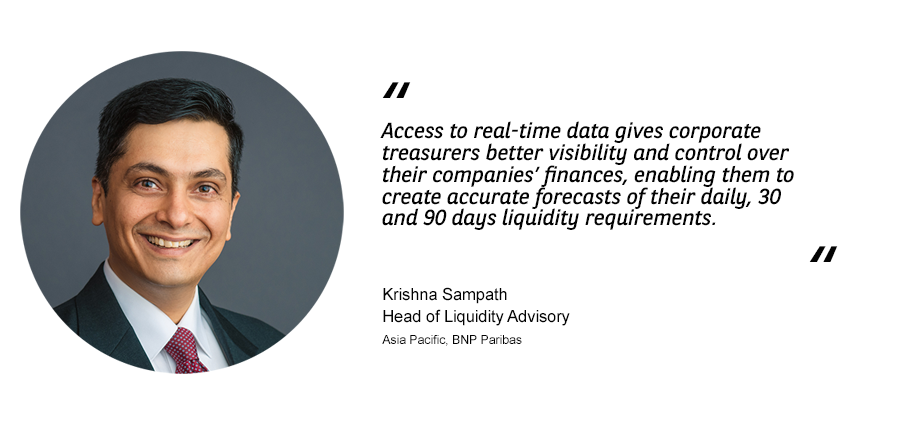In today’s 24/7 world, companies want to do more than just be able
to transact in real time. They seek a seamless and dynamic online engagement
with banks that provides them a live view of their liquidity positions, credit
facilities and utilisation, and status on documentation related issues, without
necessarily having to speak to their relationship and client service managers.
In short, treasurers want the ease and efficiency typically associated with
online shopping and access to digital tools available to retail banking
clients, to facilitate their corporate and transaction banking requirements.
However, most real-time banking services are not as instantaneous or
interactive as corporates want them to be. Historically, corporate banking has
focused more on generating value by developing product-centric and
client-centric solutions, and less on how clients interact with banks. There
has been an overwhelming focus on nurturing client relationships exclusively
through dedicated relationship managers, which in the context of real time
interactivity can be cumbersome and detracts from the overall client
experience. Furthermore, banks have been more circumspect in exploring more
interactive solutions because of risk management practices, compliance with
regulatory requirements and anti-fraud measures that necessitate elaborate
identity verification procedures.
At the same time, banks face competition from nimbler fintech firms
that are constantly churning out innovative solutions that are faster and
cheaper. Keeping up with the speed of technological change can be an expensive
gamble for banks, especially as they come under pressure from regulators who as
part of various open banking initiatives, want to allow third parties to access
customer account data in order to provide payments and other value-added
services.
To bridge this real-time gap and turn emerging competitive threats
into win-win opportunities, “banks must first understand what corporate clients
want in order to create—in collaboration with fintech firms where
necessary—innovative solutions that not only address key customer pain points,
but also benefit the banks themselves,” says Krishna Sampath, Head of Liquidity
Advisory, Asia Pacific, BNP Paribas.
|
What do corporate banking clients want? In our discussions with corporate clients, it is clear that there is not a one-size-fits-all approach that can address all their pain points. However, they were unequivocal in their expectations of banks providing them with one-stop digital solutions that can:
|

Banks are in a unique positon to be able to aggregate these connections for corporates to synchronise settlement cycles; provide a single point of entry for multiple payment networks and conduct report aggregation and harmonisation among other value added services.
Banks are in a unique position to create innovative solutions in order to bridge the real-time gap and help corporates and banks optimise liquidity and save costs.
BNP Paribas has co-created tools to aggregate information from
various e-wallets—such as those offered by Alibaba’s Alipay and Tencent’s
WeChat Pay—into a single reporting format that can be fed into a corporate’s
ERP system for reconciliation.
The tool is well suited to corporates who are
working with multiple e-wallet players in Southeast Asia, China, India and
other countries as it eliminates the need to customise the ERP for each
e-wallet.
Active liquidity management saves costs and boosts efficiency
Access to real-time data gives corporate treasurers better
visibility and control over their companies’ finances, enabling them to create
accurate forecasts of their daily, 30 and 90 days liquidity requirements. By
actively managing liquidity, treasurers stand to lower liquidity costs by
deploying cash more efficiently thus improving interest yields and in some
cases reducing the need to maintain, expensive overdraft limits.
Banks too stand to gain from having to provide corporates less
intraday liquidity through overdrafts, for which they must maintain liquidity
reserves. These reserves come at significant funding
costs that can run into hundreds of millions of dollars annually for large
banks. By enabling more real-time transactions and data access to corporates,
banks stand to reduce the demand for intraday overdrafts, optimise their own
liquidity, improve risk management and deploy scarce funds more productively.
